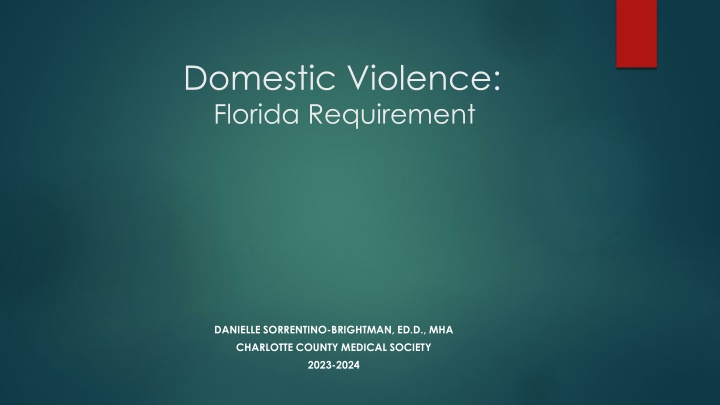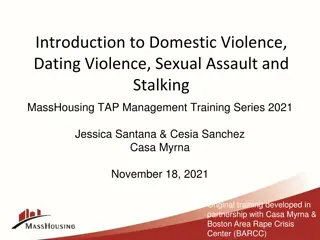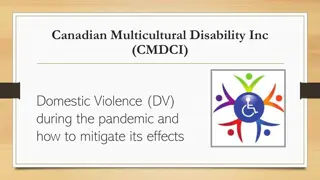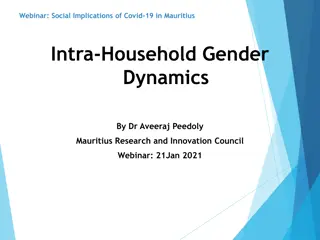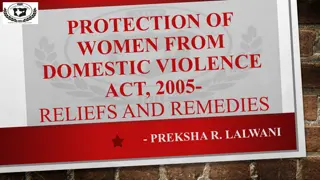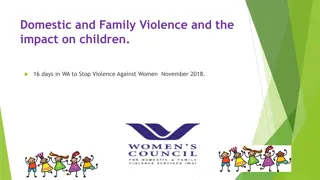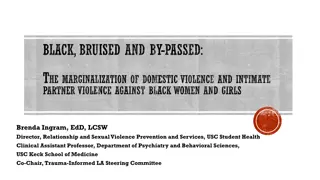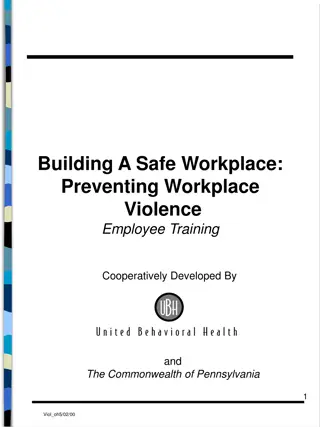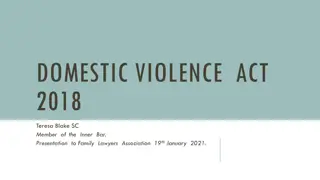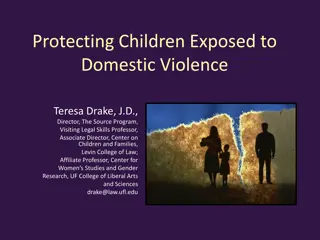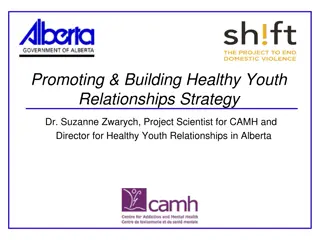Domestic Violence in Healthcare
Domestic violence is a pressing issue affecting many individuals in the United States. Healthcare professionals play a crucial role in identifying and supporting victims. This course aims to educate healthcare workers on recognizing domestic violence, assessing victims, and connecting them with necessary resources in Florida.
Uploaded on Mar 05, 2025 | 2 Views
Download Presentation

Please find below an Image/Link to download the presentation.
The content on the website is provided AS IS for your information and personal use only. It may not be sold, licensed, or shared on other websites without obtaining consent from the author.If you encounter any issues during the download, it is possible that the publisher has removed the file from their server.
You are allowed to download the files provided on this website for personal or commercial use, subject to the condition that they are used lawfully. All files are the property of their respective owners.
The content on the website is provided AS IS for your information and personal use only. It may not be sold, licensed, or shared on other websites without obtaining consent from the author.
E N D
Presentation Transcript
Domestic Violence: Florida Requirement DANIELLE SORRENTINO-BRIGHTMAN, ED.D., MHA CHARLOTTE COUNTY MEDICAL SOCIETY 2023-2024
Learning Objectives Upon completion of this course, you should be able to: 1. Define domestic violence and its impact on health care. 2. Cite the general prevalence of domestic violence on a national and state level and identify state laws pertaining to the issue. 3. Describe how to screen and assess individuals who may be victims or perpetrators of domestic violence, including the importance of conducting a culturally sensitive assessment. 4. Identify community resources presently available for domestic violence victims and their perpetrators throughout Florida concerning legal aid, shelter, victim and batterer counseling, and child protection services.
Introduction Domestic violence continues to be a prevalent problem in the United States today. Because of the number of individuals affected, it is likely that most healthcare professionals will encounter patients in their practice who are victims. Accordingly, it is essential that healthcare professionals are taught to recognize and accurately interpret behaviors associated with domestic violence. It is incumbent upon the healthcare professional to establish and implement protocols for early identification of domestic violence victims and their abusers. In order to prevent domestic violence and promote the wellbeing of their patients, healthcare professionals in all settings should take the initiative to properly assess all women for abuse during each visit and, for those women who are or may be victims, to offer education, counseling, and referral information.
Introduction cont Victims of domestic violence suffer emotional, psychological, and physical abuse, all of which can result in both acute and chronic signs and symptoms of physical and mental disease, illness, and injury. Frequently, the injuries sustained require abused victims to seek care from healthcare professionals immediately after their victimization. Subsequently, physicians and nurses are often the first healthcare providers that victims encounter and are in a critical position to identify domestic violence victims in a variety of clinical practice settings where victims receive care. Accordingly, each healthcare professional should educate himself or herself to enhance awareness of the presence of abuse victims in his or her particular practice or clinical setting.
Introduction cont Specifically, healthcare professionals should be aware of the signs and symptoms associated with domestic violence. In addition, when family violence cases are identified, there should be a plan of action that includes providing information on, and referral to, local community resources related to legal aid, sheltering, victim counseling, batterer counseling, advocacy groups, and child protection.
DEFINING DOMESTIC VIOLENCE Domestic violence, which is sometimes also referred to as spousal abuse, battering, or intimate partner violence (IPV), refers to the victimization of an individual with whom the abuser has or has had an intimate or romantic relationship. Researchers in the field of domestic violence have not agreed on a uniform definition of what constitutes violence or an abusive relationship. The Centers for Disease Control and Prevention (CDC) defines IPV as, physical violence, sexual violence, stalking, and psychological aggression (including coercive acts) by a current or former intimate partner. [1]. According to the Florida Department of Children and Families, domestic violence is a pattern of behaviors that adults or adolescents use against their intimate partners or former partners to establish power and control. It may include physical abuse, sexual abuse, emotional abuse, and economic abuse. It may also include threats, isolation, pet abuse, using children, and a variety of other behaviors used to maintain fear, intimidation, and power over one s partner
DEFINING DOMESTIC VIOLENCE cont Florida law defines domestic violence as any assault, aggravated assault, battery, aggravated battery, sexual assault, sexual battery, stalking, aggravated stalking, kidnapping, false imprisonment, or any criminal offense resulting in physical injury or death of one family or household member by another family or household member [3]. Family or household members, according to Florida definition, must reside in the same single dwelling unit, with the exception of persons who have a child in common [3]. Domestic violence knows no boundaries. It occurs in intimate relationships regardless of race, religion, culture, or socioeconomic status [2]. Whatever the definition, it is important for healthcare professionals to understand that domestic violence, in the form of emotional and psychological abuse, sexual abuse, and physical violence, is prevalent in our society. Because of the similar nature of the definitions, this course will use the terms domestic violence and IPV interchangeably.
NATIONAL AND STATE STATISTICS AND LEGISLATION Domestic violence is one of the most serious public health problems in the United States [4]. More than 26% of women and 15.9% of men 18 years of age and older have a lifetime history of IPV [5]. Furthermore, in Florida, the weighted lifetime prevalence of IPV (including rape, physical violence, and/or stalking) is 34.2% among women and 24.6% among men [4]. Although many of these incidents are relatively minor and consist of pushing, grabbing, shoving, slapping, and hitting, IPV results in more than 2,000 deaths in the United States each year, with 205 deaths reported in Florida in 2014 [6; 7; 8]. One of the difficulties in addressing the problem is that abuse is prevalent in all demographics, regardless of age, ethnicity, race, religious denomination, education, or socioeconomic status [2].
Florida In response to troubling domestic violence statistics, Governor Lawton Chiles appointed a Task Force on Domestic Violence on September 28, 1993, to investigate the problems associated with domestic violence in Florida and to compile recommendations as to how the problems should be approached and ultimately resolved. On January 31, 1994, the Task Force issued its first report on domestic violence. This report recommended standards to accurately measure the extent of domestic violence and strategies for increasing public awareness and education. It identified programs and resources that are available to victims in Florida, made legislative and budgetary suggestions for needed changes, provided a methodology for implementing these changes, and identified areas of domestic violence that require further study. As a result of this report, Florida enacted legislation during the 1995 session implementing various suggestions of the Task Force. Specifically, the Legislature amended Section 455.222 of the Florida Statutes to require that all physicians, osteopaths, nurses, dentists, dental hygienists, midwives, psychologists, and psychotherapists obtain, as part of their biennial continuing education requirements, a one-hour continuing education course on domestic violence [17]
IDENTIFYING GROUPS AT RISK FOR DOMESTIC VIOLENCE Healthcare professionals are in a critical position to identify domestic violence victims in a variety of clinical practice settings. Nurses are often the first healthcare provider a victim of domestic violence will encounter in a healthcare setting and should therefore be prepared to provide care and support for these victims. Although women are most often the victims, domestic violence extends to others in the household as well. For example, domestic violence includes abused men, children abused by their parents or parents abused by their children, elder abuse, and abuse among siblings [3].
IDENTIFYING GROUPS AT RISK FOR DOMESTIC VIOLENCE cont PREGNANT WOMEN Because a gynecologist or obstetrician is frequently a woman s primary care physician, the American College of Obstetricians and Gynecologists recommends that all women be routinely assessed for signs of IPV (i.e., physical and psychological abuse, reproductive coercion, and progressive isolation), including during prenatal visits, and providers should offer support and referral information for those being abused [28]. According to the CDC, IPV affects as many as 324,000 pregnant women each year [25]. A meta-analysis of 92 independent studies found that the average reported prevalence of emotional abuse during pregnancy was 28.4%, physical abuse was 13.8%, and sexual abuse was 8%. As with all domestic violence statistics, these estimates are presumed to be lower than the actual incidence as a result of under-reporting and lack of data on women whose pregnancies ended in fetal or maternal death. This makes IPV more prevalent among pregnant women than some of the health conditions included in prenatal screenings, including pre-eclampsia and gestational diabetes [25]. Because 96% of pregnant women receive prenatal care, this is an optimal time to assess for domestic violence and develop trusting relationships with the women.
IDENTIFYING GROUPS AT RISK FOR DOMESTIC VIOLENCE cont CHILDREN Children exposed to family violence are at high risk for abuse and for emotional damage that may affect them as they grow older. The Department of Justice estimates that of the 76 million children in the United States, 46 million will be exposed to some type of violence during their childhood [52]. Results of the National Survey of Children s Exposure to Violence indicated that 11% of children were exposed to IPV at home within the last year, and as many as 26% of children were exposed to at least one form of family violence during their lifetimes [31]. Of those children exposed to IPV, 90% were direct eyewitnesses of the violence; the remaining children were exposed by either hearing the violence or seeing or being told about injuries [31]. Of note, according to Florida criminal law, witnessing domestic violence is defined as violence in the presence of a child if an offender is convicted of a primary offense of domestic violence, and that offense was committed in the presence of a child under age 16 who is a family or household member with the victim or perpetrator [32].
IDENTIFYING GROUPS AT RISK FOR DOMESTIC VIOLENCE cont ELDERLY Abused and neglected elders, who may be mistreated by their spouses, partners, children, or other relatives, are among the most isolated of all victims of family violence. In a national study conducted by the National Institute of Justice in 2010, 4.6% of participants (community dwelling adults 60 years of age or older) were victims of emotional abuse in the past year, 1.6% physical abuse, 0.6% sexual abuse, 5.1% potential neglect, and 5.2% current financial abuse by a family member [38]. The estimated annual incidence of all elder abuse types is 2% to 10%, but it is believed to be severely under-measured. According to one study, only 1 in 14 cases of elder abuse are reported to the authorities.
IDENTIFYING GROUPS AT RISK FOR DOMESTIC VIOLENCE cont ELDERLY The prevalence rate of elder abuse in institutional settings is not clear. However, in one nonprobability study, 36% of nursing and aide staff disclosed to having witnessed at least one incident of physical abuse by other staff members in the preceding year. When asked whether they themselves perpetrated physical abuse against an elderly resident, 10% admitted they had. In a random sample survey, 24.3% of respondents reported at least one incident of elder physical abuse perpetrated by a nursing home staff member. As healthcare professionals in Florida, which leads the nation in percentage of older residents, it is important to understand that the needs of older Floridians will increase as will the numbers of elder victims of domestic violence. Because elder abuse can occur in family homes, nursing homes, board and care facilities, and even medical facilities, healthcare professionals should remain keenly aware of the potential for abuse.
IDENTIFYING GROUPS AT RISK FOR DOMESTIC VIOLENCE cont ELDERLY It is important to understand that the domestic violence dynamic involves not only a victim but a perpetrator as well. For example, an adult son or daughter who lives in the parents home and depends on the parents for financial support may be in a position to inflict abuse. This abuse may not always manifest itself as violence, but can lead to an environment in which the elder parent is controlled and isolated. The elder may be hesitant to seek help because the abuser s absence from the home may leave the elder without a caregiver. Because these elderly victims are often isolated, dependent, infirm, or mentally impaired, it is easy for the abuse to remain undetected. Healthcare professionals in all settings should remain aware of the potential for abuse and keep a watchful eye on this particularly vulnerable group.
IDENTIFYING GROUPS AT RISK FOR DOMESTIC VIOLENCE cont MEN Statistics confirm that domestic violence is predominantly perpetrated by men against women; however, there is evidence to suggest that women also exhibit violent behavior against their male partners [4]. Studies demonstrate approximately 5% of murdered men are killed by intimate partners. It is persuasively argued that the impact on the health of female victims of domestic violence is generally much more severe than the impact on the health of male victims. Approximately 512,770 women were raped and/or physically assaulted by an intimate partner in 2008, compared to 101,050 men.
IDENTIFYING GROUPS AT RISK FOR DOMESTIC VIOLENCE cont MEN In addition, 3 out of every 10 women has been physically assaulted, raped, and/or stalked by an intimate partner, compared to 1 out of every 10 men [7]. Rape, non-contact unwanted sexual experiences, and stalking against men are primarily perpetrated by other men, while other forms of violence against men were perpetrated mostly by women [4]. Male victims of IPV experienced 3 victimizations per 1,000 boys and men 12 years of age or older in 1994, and this rate decreased by 64%, to 1.1 per 1,000, in 2010 [11]. Of all homicides committed against men between 1980 and 2008, 7.1% were committed by an intimate partner [36]. Although women are more often victims of IPV, healthcare professionals should always keep in mind that men can also be victimized and assess accordingly.
IDENTIFYING GROUPS AT RISK FOR DOMESTIC VIOLENCE cont LESBIAN, GAY, BISEXUAL, AND TRANSGENDER VICTIMS Domestic violence exists in lesbian, gay, bisexual, and transgender (LGBT) communities, and the rates are thought to mirror those of heterosexual women approximately 25%. However, women living with female intimate partners experience less IPV than women living with men [6]. Conversely, men living with male intimate partners experience more IPV than do men who live with female intimate partners [6]. In addition, 76% of all IPV homicide victims in 2013 were gay men [24]. This supports other statistics indicating that IPV is perpetrated primarily by men. A form of abuse specific to the gay community is for an abuser to threaten or to proceed with outing a partner to others [43; 59].
IDENTIFYING GROUPS AT RISK FOR DOMESTIC VIOLENCE cont LESBIAN, GAY, BISEXUAL, AND TRANSGENDER VICTIMS Transgender individuals appear to be at particular risk for violence. According to a large national report, transgender victims of IPV were 1.9 times more likely to experience physical violence and 3.9 times more likely to experience discrimination than other members of the LGBT community. Because of the stigma of being LGBT, victims may be reticent to report abuse and afraid that their sexual orientation or biological sex will be revealed. In one study, the three major barriers to seeking help were a limited understanding of the problem of LGBT IPV, stigma, and systemic inequities. Many in this community feel that support services (e.g., shelters, support groups, crisis hotlines) are not available to them due to homophobia of the service providers. Unfortunately, this results in the victim feeling isolated and unsupported. Healthcare professionals should strive to be sensitive and supportive when working with homosexual patients.
CHARACTERISTICS OF PERPETRATORS OF DOMESTIC VIOLENCE Abuser characteristics have been studied far less frequently than victim characteristics. Some studies suggest a correlation between the occurrence of abuse and the consumption of alcohol. A man who abuses alcohol is also likely to abuse his mate, although the abuser may not necessarily be inebriated at the time the abuse is inflicted. Domestic violence assessment questionnaires should include questions that explore social drinking habits of both victims and their mates.
CHARACTERISTICS OF PERPETRATORS OF DOMESTIC VIOLENCE cont Other studies demonstrate that abusive mates are generally possessive and jealous. Another characteristic related to the abuser s dependency and jealousy is extreme suspiciousness. This characteristic may be so extreme as to border on paranoia [12]. Domestic violence victims frequently report that abusers are extremely controlling of the everyday activities of the family. This domination is generally all encompassing and often includes maintaining complete control of finances and activities of the victim (e.g., work, school, social interactions).
CHARACTERISTICS OF PERPETRATORS OF DOMESTIC VIOLENCE cont In addition, abusers often suffer from low self-esteem and their sense of self and identity is directly connected to their partner [12]. Extreme dependence is common in both abusers and those being abused. Due to low self-esteem and self-worth, emotional dependence often occurs in both partners, but even more so in the abuser. Emotional dependence in the victim stems from both physical and psychological abuse, which results in a negative self-image and lack of self- worth. Financial dependence is also very common, as the abuser often withholds or controls financial resources to maintain power over the victim.
SCREENING FOR DOMESTIC VIOLENCE AND ABUSE There is no universal guideline for identifying and responding to domestic violence, but it is universally accepted that a plan for screening, assessing, and referring patients of suspected abuse should be in place at every healthcare facility. Guidelines should review appropriate interview techniques for a given setting and should also include the utilization of assessment tools. Furthermore, protocols within each facility or healthcare setting should include referral, documentation, and follow-up. The CDC has provided a compilation of assessment tools for healthcare workers to assist in recognizing and accurately interpreting behaviors associated with domestic violence and abuse, which may be accessed at https://www.cdc.gov/violenceprevention/pdf/ipv/ipvandsvscreening.pdf [45].
SCREENING FOR DOMESTIC VIOLENCE AND ABUSE cont Several barriers to screening for domestic violence have been noted, including a lack of knowledge and training, time constraints, lack of privacy for asking appropriate questions, and the sensitive nature of the subject [35]. Although awareness and assessment for IPV has increased among healthcare providers, many are still hesitant to inquire about abuse [46]. At a minimum, those exhibiting signs of domestic violence should be screened. Although victims of IPV may not display typical signs and symptoms when they present to healthcare providers, there are certain cues that may be attributed to abuse. The obvious cues are physical. Injuries range from bruises, cuts, black eyes, concussions, broken bones, and miscarriages to permanent injuries such as damage to joints, partial loss of hearing or vision, and scars from burns, bites, or knife wounds. Typical injury patterns include contusions or minor lacerations to the head, face, neck, breast, or abdomen and musculoskeletal injuries. These are often distinguishable from accidental injuries, which are more likely to involve the extremities of the body. Abuse victims are also more likely to have multiple injuries than accident victims. When this pattern of injuries is seen, particularly in combination with evidence of old injury, physical abuse should be suspected [44].
SCREENING FOR DOMESTIC VIOLENCE AND ABUSE cont In addition to physical signs and symptoms, domestic violence victims also exhibit psychological cues that resemble an agitated depression. As a result of prolonged stress, various psychosomatic symptoms that generally lack an organic basis often manifest. For example, complaints of backaches, headaches, and digestive problems are common. Often, there are reports of fatigue, restlessness, insomnia, or loss of appetite. Great amounts of anxiety, guilt, and depression or dysphoria are also typical. Women who experienced IPV are also more likely to report asthma, irritable bowel syndrome, and diabetes [4]. Healthcare professionals should look beyond the typical symptoms of a domestic violence victim and work within their respective practice settings to develop appropriate assessment mechanisms to detect victims who exhibit less obvious symptoms.
SCREENING FOR DOMESTIC VIOLENCE AND ABUSE cont The unique relationship dynamics of the abuser and abused are not easily detected under the best of circumstances. They may be especially difficult to uncover in circumstances in which the parties are suspicious and frightened, as might be expected when a victim presents to the emergency department. The key to detection, however, is to establish a proper assessment tool that can be utilized in the particular setting and to maintain a keen awareness for the cues described in this course. Screening for IPV should be carried out at the entry points of contact between victims and medical care (e.g., primary care, emergency services, obstetric and gynecologic services, psychiatric services, and pediatric care).
SCREENING FOR DOMESTIC VIOLENCE AND ABUSE cont The key to an initial assessment is to obtain an adequate history. Establishing that a patient s injuries are secondary to abuse is the first task. Clearly, there will be times when a victim is injured so severely that treatment of these injuries becomes the first priority. After such treatment is rendered, however, it is important that healthcare professionals not ignore the reasons that brought the victim to the emergency department.
ASSESSING DOMESTIC VIOLENCE AND ABUSE Healthcare providers have reported that even if routine screening and inquiry results in a positive identification of IPV, the next steps of assessing and referring are often difficult, and many feel that they are not adequately prepared. According to the Family Violence Prevention Fund, the goals of the assessment are to create a supportive environment, gather information about health problems associated with the abuse, and assess the immediate and long-term health and safety needs for the patient to develop an intervention.
ASSESSING DOMESTIC VIOLENCE AND ABUSE cont EXAMPLE ? s OF AN ASSESSMENT OF IMMEDIATE SAFETY FOR DOMESTIC VIOLENCE VICTIMS Are you in immediate danger? Is your partner at the health facility now? Do you want to (or have to) go home with your partner? Do you have somewhere safe to go? Have there been threats or direct abuse of the children (if s/he has children)? Are you afraid your life may be in danger? Has the violence gotten worse or is it getting scarier? Is it happening more often? Has your partner used weapons, alcohol or drugs? Has your partner ever held you or your children against your will? Does your partner ever watch you closely, follow you or stalk you? Has your partner ever threatened to kill you, him/herself or your children?
ASSESSING DOMESTIC VIOLENCE AND ABUSE cont Assessment of domestic violence victims should occur immediately after disclosure of abuse and at any follow-up appointments. Assessing immediate safety is priority. Having a list of questions readily available and well-practiced can help alleviate the uncertainty of how to begin to the assessment. If the patient is in immediate danger, referral to an advocate, support system, hotline, or shelter is indicated. If the patient is not in immediate danger, the assessment may continue with a focus on the impact of IPV on the patient s mental and physical health and the pattern of history and current abuse. These responses will help formulate an appropriate intervention
CULTURALLY SENSITIVE ASSESSMENT During the assessment process, a practitioner should be open and sensitive to the patient s worldview, cultural belief systems and how he/she views the illness. Culturally sensitive assessment involves a dynamic framework whereby the practitioner engages in a continual process of questioning. By incorporating cultural sensitivity into the assessment of individuals with a history of being victims or perpetrators of domestic violence, it may be possible to intervene and offer treatment more effectively.
INTERVENTIONS FOR DOMESTIC VIOLENCE AND ABUSE After the assessment is complete, the patient may or may not want immediate assistance or referral. It is important for healthcare providers to assure patients in a nonjudgmental manner that the decision of what they would like in terms of assistance is their choice and that the provider will help regardless of the decisions they are currently ready to make. If the patient would like to immediately implement a plan of action, information for referral to a local domestic violence shelter to assist the victim and the victim s family should be readily available. The acute situation should be referred immediately to local law enforcement officials. Other resources in an acute situation include crisis hotlines and rape relief centers. After a victim is introduced into the system, counseling and follow-up are generally available by individual counselors who specialize in the care of battered women and their spouses and children. These may include social workers, psychologists, psychiatrists, other mental health workers, and community mental health services.
INTERVENTIONS FOR DOMESTIC VIOLENCE AND ABUSE cont The goals are to make the resources accessible and safe and to enhance support for those who are unsure of their options [35]. In Florida, a 24-hour domestic violence hotline is available for toll-free counseling and information. The number is 800-500-1119. The counselors answering the toll-free line may refer the victim to her or his local domestic violence center. A list of Florida certified domestic violence centers organized by county and city may also be found on the Florida Coalition Against Domestic Violence website at http://www.fcadv.org/centers. As of 2015, Florida had 42 certified domestic violence centers that provide information and referral services, counseling and case management services, a 24-hour hotline, temporary emergency shelter for more than 24 hours, educational services for community awareness relative to domestic violence, assessment and appropriate referral of resident children, and training for law enforcement personnel.
DOCUMENTATION AND FOLLOW-UP It is imperative that healthcare professionals document all findings and recommendations regarding domestic violence in the victim s medical record, including a patient s denial of abuse, if applicable. If domestic violence is disclosed, documentation should include relevant history, results of the physical examination, findings of laboratory and other diagnostic procedures, and results of the assessment, intervention, and referral. The medical record can be an invaluable document in establishing the credibility of the victim s story when seeking legal aid. Healthcare professionals should offer a follow-up appointment if disclosure of past or current abuse is present. Reassurance that assistance is available to the patient at any time is critical in helping to break the cycle of abuse.
Works Cited 1. Centers for Disease Control and Prevention. Intimate Partner Violence: Definitions. Available at http://www.cdc.gov/ ViolencePrevention/intimatepartnerviolence/definitions.html. Last accessed June 29, 2015. 2. Florida Department of Children and Families. What Is Domestic Violence? Available at http://www.dcf.state.fl.us/domesticviolence/ whatisdv.shtml. Last accessed June 29, 2015. 3. Florida Statutes. Section 741.28 (2014): Domestic Violence; Definitions. Available at http://www.leg.state.fl.us/statutes/index. cfm?App_mode=Display_Statute&URL=0700- 0799/0741/Sections/0741.28.html. Last accessed June 29, 2015. 4. Black MC, Basile KC, Breiding MJ, et al. The National Intimate Partner and Sexual Violence Survey (NISVS): 2010 Summary Report. Atlanta, GA: National Center for Injury Prevention and Control, Centers for Disease Control and Prevention; 2010. 5. Centers for Disease Control and Prevention. Adverse health conditions and health risk behaviors associated with intimate partner violence United States, 2005. MMWR. 2008;57(5):113-117. 6. Tjaden P, Thoennes N. Extent, Nature, and Consequences of Intimate Partner Violence. Washington, DC: NIJ; 2000. 7. Centers for Disease Control and Prevention. Understanding Intimate Partner Violence: Fact Sheet. Available at http://www.cdc. gov/ViolencePrevention/pdf/IPV_factsheet-a.pdf. Last accessed June 29, 2015. 8. Florida Department of Law Enforcement. Crime in Florida, 2014: Florida Uniform Crime Report. Available at http://www.fdle.state. fl.us/Content/FSAC/UCR/2014/CIF_annual14.aspx. Last accessed June 29, 2015. 9. National Center for Injury Prevention and Control. Costs of Intimate Partner Violence Against Women in the United States. Atlanta, GA: Centers for Disease Control and Prevention; 2003. 10. Family Violence Prevention Fund. The Health Care Costs of Domestic and Sexual Violence. San Francisco, CA: Family Violence Prevention Fund; 2010.
Works Cited cont 11. Catalano S. Intimate Partner Violence, 1993 2010. Washington, DC: Bureau of Justice Statistics, U.S. Department of Justice; 2012. 12. Capaldi DM, Knoble NB, Shortt JW, Kim HK. A systematic review of risk factors for intimate partner violence. Partner Abuse. 2012;3(2):231-280. 13. National Institute of Justice. The decline of intimate partner homicide. National Institute of Justice Journal. 2005;252. 14. Farmer A, Tiefenthaler J. Explaining the recent decline in domestic violence. Contemp Econ Policy. 2003;21(s):158-172. 15. National Domestic Violence Hotline. Press Release: Increased Financial Stress Affects Domestic Violence Victims. Available at http://www.thehotline.org/2009/01/increased-financial-stress-affects-domestic-violence-victims-2/. Last accessed June 29, 2015. 16. Crane CA, Hawes SW, Weinberger AH. Intimate partner violence victimization and cigarette smoking: a meta-analytic review. Trauma Violence Abuse. 2013;14(4):305-315. 17. 1995 Florida Session Law Service Chapter 95-187, Domestic Violence, General Provisions. 18. Florida Governor s Task Force on Domestic and Sexual Violence. Florida Mortality Review Project. Jacksonville, FL: Office of the Governor; 1997. 19. Florida Department of Law Enforcement. Florida Domestic Violence Fatality Review Team Annual Report, 2001. Available at https://www.dcf.state.fl.us/programs/domesticviolence/publications/docs/FatalityReview2001.pdf. Last accessed July 1, 2015. 20. Florida Department of Law Enforcement. Florida Domestic Violence Fatality Review Team Annual Report, 2002. Available at http://www.ndvfri.org/reports/florida/Florida_Statewide_AnnualReport_2002.pdf. Last accessed July 1, 2015. 21. Florida Department of Law Enforcement. Florida Domestic Violence Fatality Review Team 2008 Annual Report: Executive Summary. Available at http://www.dcf.state.fl.us/programs/domesticviolence/publications/docs%5CFatalityReview2008.pdf. Last accessed July 1, 2015. 22. Florida Department of Children and Families. Violence Free Florida! Ending Abuse Improving Lives. Available at https://www. dcf.state.fl.us/programs/domesticviolence/publications/docs/DVAnnualReport0102.pdf. Last accessed July 1, 2015.
